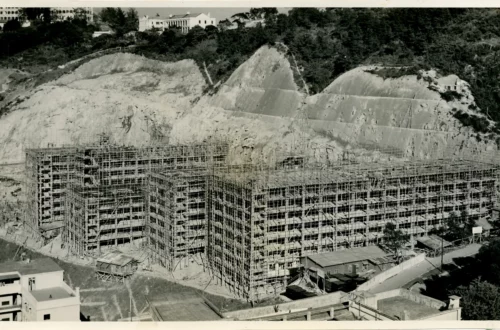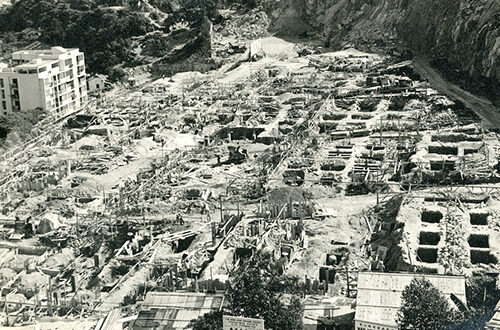Construction of Ming Wah Dai Ha Begins
with the Building of A Kung Ngam Road
Construction of Ming Wah Dai Ha Begins with the Building of A Kung Ngam Road
Tsuei Sheng Chen / Former Clerk of Works

“What I remember most vividly is the rock blasting during construction. The site was just a slope back then; A Kung Ngam Road hadn’t been constructed yet, we had to blast rocks to make way for it.” In 1958, Tsuei, who was 29 at the time, was working for a construction consulting firm. His work on Four Seasons Estate in Tsuen Wan, a housing project commissioned by the Housing Society, was nearing an end when he was assigned to a new project: Ming Wah Dai Ha in Shau Kei Wan. Though the construction ended over half a century ago, Tsuei, who turned 93 this year, still remembers it like it was yesterday.
Building, stone breaking and road paving by hand
Tsuei graduated from Hong Kong Technical College (now The Hong Kong Polytechnic University) and had been working at a construction consulting firm as a clerk of works since graduation. “I was a clerk of works, people called it CW, which is somewhat like a project manager in modern terms. I was responsible for monitoring construction progress at the site and discussing plans with architects; I knew everything about what was happening on the site.”
After receiving the architectural drawings in 1958, he started communicating to workers about how to proceed with the construction. “There was no machinery back then, most of the construction was done by hand. To make concrete, for example, we put aggregate and cement in a barrel and mixed it by hand. Times have changed though, nowadays we have concrete mixers and motors.” How did workers at the time manage to drive piles into the ground without the help of machines? “We didn’t drive piles; we dug the foundation by hand (with the aid of tools).”
At the time of the construction, Tsuei was living in Wan Chai. Every day he would take a tram or a bus to Shau Kei Wan and climb a slope to reach the site. Back then, Chai Wan Road, where Salesian School is today, was already well developed, but A Kung Ngam Road was merely a steep hill. “We blasted rocks every day at 12. Workers would drill holes in the rock and place explosives in them, then keep pedestrians away with a gong before detonation.” As late as 1962, when the first phase of Ming Wah Dai Ha was completed and residents started to move in, workers were still blasting rocks every day, and residents remember the experience even to this day. (See Daniel’s Interview Link)
Introducing seawater toilet flushing by building pipes along A Kung Ngam Road
Tsuei explained that, back in the olden days, Ming Wah Dai Ha was a large-scale construction project that garnered wide attention as the largest public housing estate on Hong Kong Island, and its completion was eagerly anticipated by the public in general. “Ming Wah Dai Ha featured a particularly spacious corridor design, with impluvium (air wells) installed at either end of the corridor and the flats facing the hills. It’s a decent living space.” Another modern design incorporated was the private bathroom and kitchen in each flat. “A flush toilet was installed in every unit, it’s all very hygienic. We bought them especially from the UK. They were black and durable.” According to historical records, Hong Kong suffered from a severe freshwater shortage in the late 1950s and the viability of seawater flushing was being explored. Ming Wah Dai Ha, which was completed in the early 1960s, was one of the first residential buildings to implement a seawater flushing system. “Introducing seawater flushing means building pipes and pumps. We built them along A Kung Ngam Road from Ming Wah Dai Ha all the way to the waterfront. It was a long way; we’re talking about one to two miles, at a time when there weren’t any shops on the road yet.”
Ming Wah Dai Ha comprised 13 blocks, and was completed in phases starting from 1962. A plaque unveiling ceremony was officiated by the then Governor of Hong Kong, Sir David Trench. Tsuei recalled that he spent almost 10 years working on the Ming Wah Dai Ha project before he was transferred to the Mei Sun Lau project in Sai Wan (the first project of the Housing Society’s Urban Improvement Scheme). Later, he joined the Housing Society and had since worked on public housing estate projects all over Hong Kong.

Bustling construction site of Ming Wai Dai Ha.
.jpeg-的副本-1-500x330.jpg)
Tsuei was the clerk of works for the construction project of Ming Wah Dai Ha.
。-1.jpg-的副本-1-500x330.jpg)
The proposed construction scope of Ming Wah Dai Ha in the 1950s. (White dotted line)

The construction of Ming Wah Dai Ha was progressing well in 1965.

In the 1960s, the newly completed Ming Wah Dai Ha.
Connection to Ming Wah Dai Ha: Joined the construction project as the clerk of works in 1958; responsible for managing the entire project
細説明華
Ming Wah Dai Ha
Documentary Project
Copyright|Disclaimer | Contact us
Organiser|Hong Kong Housing Society
Collaborator|Dragon Foundation、Lion Head Culture、Hide and Seek Tour
Copyright © 2024 Hong Kong Housing Society. All Rights Reserved.
細説明華
Ming Wah Dai Ha
Documentary Project
Copyright|Disclaimer | Contact us
Organiser|Hong Kong Housing Society
Collaborator|Dragon Foundation、Lion Head Culture、Hide and Seek Tour
Copyright © 2024 Hong Kong Housing Society. All Rights Reserved.